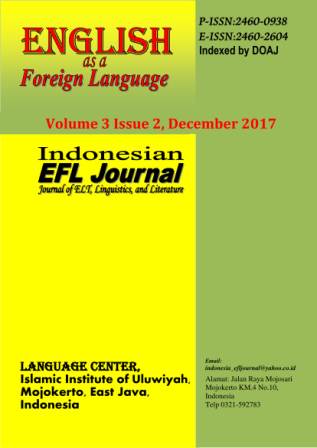Validity and Reliability of English Summative Test for Senior High School
Abstract
This study aims to analyze statistically the validity and reliability of English summative test for the second semester of the tenth graders of SMAN 2 Palangka Raya in academic year 2015/2016. The writer used descriptive quantitative approach to find the result. In analyzing the validity, the writer used Point-biserial correlation formula, while to analyze the reliability, the writer used K-R20 formula. The validity was analyzed based test item, and the validity of whole test was determined based on the percentage of all valid items. The result was that the English summative test was valid and reliable. Specifically, from 50 items of questions, 32 items (64%) were valid and 18 items (36%) were invalid. Interpreted from the 64% of valid items, so overall the summative test was valid in substantial level. The summative test was also reliable. The coefficient of reliability was .907. Therefore, the reliability was in the level of excellent reliability.
References
Brown, J. D. (2001). Point-biserial correlation coefficients. JALT Testing & Evaluation SIG Newsletter, 5(3), 12–15.
Brown, J. D. (2005). Testing in Language Programs. New York: McGraw-Hill.
Claritha, F. (2006). An analysis of the summative test made by the teacher of SMP Katolik Palangka Raya (Unpublished). Palangka Raya University.
Djiwandono, S. (2008). Tes Bahasa. Jakarta: PT. Indeks.
Fauzi, S. (2011). An analysis of the content validity of the English summative test for the second grade of Madrasah Tsanawiyah Salafiyah Bedahan Kota Depok. UIN Syarif Hidayatullah Jakarta, Jakarta. Retrieved from http://repository.uinjkt.ac.id/dspace/bitstream/123456789/3026/1/SALMAN%20FAUZI-FITK.pdf
Garrison, C., & Ehringhaus, M. (2007). Formative and summative assessments in the classroom. Retrieved from http://ccti.colfinder.org/sites/default/files/formative_and_summative_assessment_in_the_classroom.pdf
Haryudin, A. (2015). Validity and reliability of English summative tests at junior high school in West Bandung. P2M STKIP Siliwangi, 2(1), 77–90.
Hughes, A. (2003). Testing for Language Teachers (2nd ed.). Cambridge: Cambridge University Press.
Marleni, M. (2006). An analysis of validity of English summative test constructed by the teachers for the seventh grade students of SLTPN-1 Pahandut (Unpublished). Palangka Raya University.
Qu, W., & Zhang, C. (2013). The analysis of summative assessment and formative assessment and their roles in college English assessment system. Journal of Language Teaching and Research, 4(2). https://doi.org/10.4304/jltr.4.2.335-339
Rajhy, H. A. A. (2014). Five characteristics of a good language test. National Journal of Extensive Education and Interdisciplinary, 2(4), 61–66.
Schalich, M. E. (2015). Analysis of pre test and post test performance of students in a learning center model at the elementary school level. Dominican University of California, California. Retrieved from http://scholar.dominican.edu/cgi/viewcontent.cgi?article=1181&context=masters-theses
Setiyana, R. (2016). Analysis of summative tests for English. English Education Journal, 7(4), 433–447.
Sudijono, A. (2011). Pengantar Evaluasi Pendidikan. Jakarta: Rajawali Pers.
Sugianto, A. (2011). Analysis of validity and reliability of English formative tests. Journal on English as a Foreign Language, 1(2), 87–94.
Sugianto, A. (2016a). An analysis of English National Final Examination for junior high school in terms of validity and reliability. Journal on English as a Foreign Language, 6(1), 31–42.
Sugianto, A. (2016b). Technique and procedure of statistical analysis of test item validity of objective English language test. In 21st Century English Language Teaching (Vol. 2, pp. 5–18). IAIN Palangka Raya. Retrieved from https://www.researchgate.net/profile/Karya_Ilmiah_Tadris_Bahasa_Inggris/publication/313045322_Proceeding_21st_Century_English_Language_Teaching/links/588eaee6a6fdcc8e63cac784/Proceeding-21st-Century-English-Language-Teaching.pdf#page=6
Sugianto, A. (2016c). Types of variable data (discreet variable and continuous variable). In Role of International Languages toward Global Education System (pp. 5–7). IAIN Palangka Raya. Retrieved from https://www.researchgate.net/profile/Karya_Ilmiah_Tadris_Bahasa_Inggris/publication/311570913_Proceedings_of_International_Conference_Role_of_International_Languages_toward_Global_Education_System/links/584d871308ae4bc899330a31.pdf#page=10
Copyright (c) 2017 Indonesian EFL Journal: Journal of ELT, Linguistics, and Literature

This work is licensed under a Creative Commons Attribution-ShareAlike 4.0 International License.
All rights reserved.
this publication may be reproduced, stored in a retrieval system, or transmitted
in any form or by any means, electronic, mechanical, photocopying, recording.




